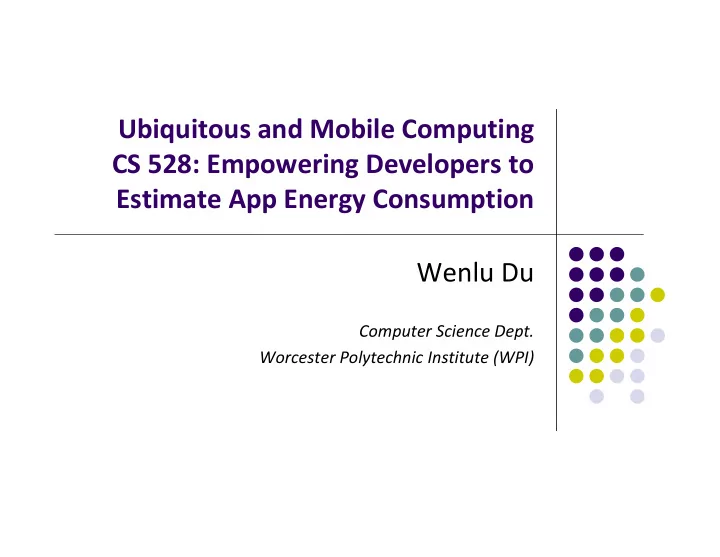

Ubiquitous and Mobile Computing CS 528: Empowering Developers to Estimate App Energy Consumption Wenlu Du Computer Science Dept. Worcester Polytechnic Institute (WPI)
Introduction of Background Why it is important to estimate App energy consumption? Pooly written app: consume 30% ‐ 40% phone's battery Critical performance and user experience metric What factors affect the battery life? network congestion choice of mobile operator user settings for screen brightness
Method to Improve Battery Life Higher battery density Platform layer Dedicated low power processors improvements Optimizing the battery impact of background OS service ‐‐‐‐‐‐‐ >OS designers' task Optimizing the battery impact of interactive foreground apps (significant portion of battery is used here) ‐‐‐‐‐‐‐ > app developpers' task power meter to measure the energy "battery use"tool : nokia energy profiler(NEP) / eProf
Related Work Power Scope:tracks the application with the active context on the processor and measure the power eProf:traces system calls made by applications and uses power state models for various components to infer energy used. TOSSIM OLED/LCD Model
Introduction of WattsOn identify engergy hungry segments during the app run. determine which component(display, network or CPU) consumes the most energy. Emulates the display, network, CPU only Dominant energy consumers, consuming 800 ‐ 1500mW Others like GPU(250 ‐ 350mW)and A ‐ GPS(160 ‐ 350mW) ‐‐ small fraction
WattsOn System It is the first system that can estimate app engergy consumption in different operating options. Enable to be profiled within the development environment without requiring a specific mobile device. Expand the catelogue of power models available for mobile devices. Validate WattsOn with multiple applications, devices, network, carrier. 4% ‐ 9% error.
WattsOn System Design Two major techniques 1) power modeling 2)resource scaling
WattsOn System Implementation The input encapsulated into XML file, energy use across multiple devices emulation. 1) A time series of power consumed for every component. 2)The total energy consumed. http://www.logicpd.com/products/software/wattson/
Cellular Network(3G) Resource scaling 1)Virtual Clock: simply record time in ticks 2)Trace Stretching: capture the packet activity over the high speed network and stretch the timing characteristic to match those on the lower speed link. 3)Link Shaping : shape the network link bandwidth,latency and loss. layer 2.3(between IP and MAC layer) distribution based model
Cellular Network(3G) Power Modeling ARO model tail time: active state(DCH) intermediate state (FACH) powered intermediate state (PCH)
WIFI Network Resource scaling Not needed or the same with cellular network Power model Use PSM model(contains 4 states) Deep sleep(10 mW) Light sleep(120 mW) Idle(400 mW) High(600 mW)
Display Emulators alreday provide resource scaling Power Model Prior work has provided power models for LCD and OLED. AMOLED : not fit existing model OLED: sum of the energy consumption of R, G, B, linear AMOLED: both additive and lineariry properties break down not only depends on the area but also varies by color
Display Power model Use a look up table 16 color magnitudes per component 16*16*16 entries contain power value
CPU Resource Scaling detailed cycle ‐ accurate simulation ‐‐‐ >impratical Scale down the performance by restricting the processor cycles available for the movile device emulator. Mobile device processor:(SAMSUNG) 1GHz Scorping CPU 100% Development machine: 2.7GHz Intel core ‐ 2 Quad core processor. 13.8%/core Slow down:7.2 Power model
Performance Evaluation
Case study Image dose not help save energy The displaying is consuming the largest CPU energy consumption of the third is the highest
Conclusion and Future Work Present a system to estimate energy consumption. Use feedback to write more energy efficient app. Test the app's energy consumption under various scenarios and operating conditions. Obtain the measurements from the wild. Augment power models with real measurements data.
References
Thank you for your attention. Any questions?
Recommend
More recommend